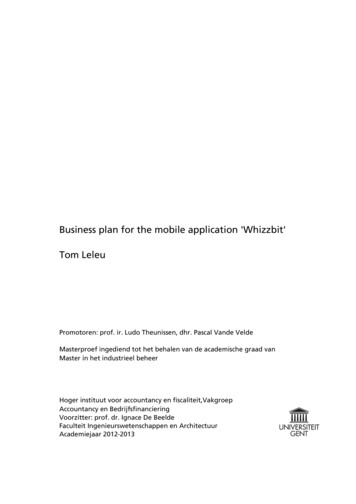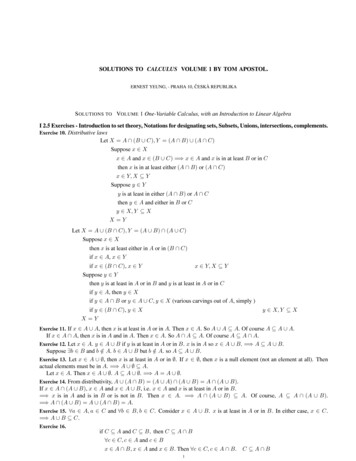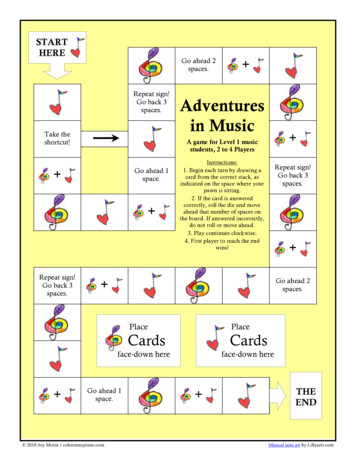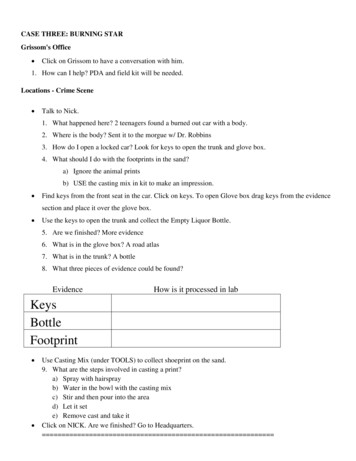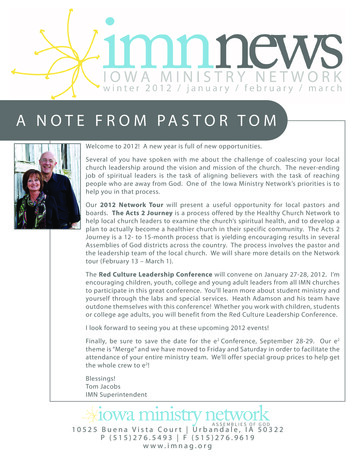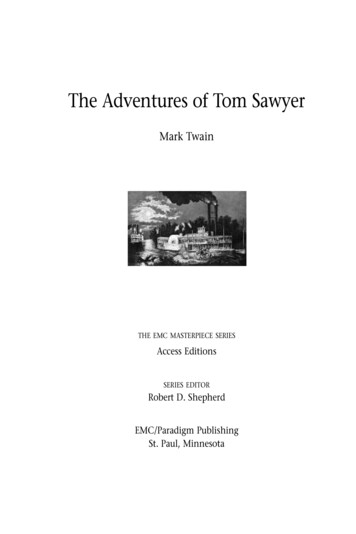
Transcription
The Adventures of Tom SawyerMark TwainTHE EMC MASTERPIECE SERIESAccess EditionsSERIES EDITORRobert D. ShepherdEMC/Paradigm PublishingSt. Paul, Minnesota
S t a ff Cr ed its:For E M C/ P ar a di gm P u bl ishi ng, St. Paul, MinnesotaLaurie SkibaEditorEileen SlaterEditorial ConsultantShannon O’Donnell TaylorAssociate EditorJennifer J. AndersonAssistant EditorFor P e no bsc ot S ch ool Pu bl ishi ng, I nc ., Danvers, MassachusettsE di to ri alD e s i g n a n d P r o d u c t i onRobert D. ShepherdPresident, Executive EditorCharles Q. BentProduction ManagerChristina E. KolbManaging EditorSara DayArt DirectorKim Leahy BeaudetEditorDiane CastroCompositorSara HyryEditorJanet StebbingsCompositorLaurie A. FariaAssociate EditorSharon SalingerCopyeditorMarilyn Murphy ShepherdEditorial AdvisorISBN 0-8219-1637-8Copyright 1998 by EMC CorporationAll rights reserved. No part of this publication may be adapted, reproduced,stored in a retrieval system or transmitted in any form or by any means, electronic, mechanical, photocopying, recording, or otherwise without permission from the publishers.Published by EMC/Paradigm Publishing875 Montreal WaySt. Paul, Minnesota 55102Printed in the United States of America.10 9 8 7 6 5 4 3 2 xxx 06 05 04 03 02 01 00
Table of ContentsThe Life and Works of Mark Twain. . . . . . . . . . . . . . . . . . . vTime Line of Twain’s Life . . . . . . . . . . . . . . . . . . . . . . . . . viiThe Historical Context of The Adventures of Tom Sawyer . . . ixCharacters in The Adventures of Tom Sawyer . . . . . . . . . . xiiiIllustrations . . . . . . . . . . . . . . . . . . . . . . . . . . . . . . . . . . . . xviEchoes . . . . . . . . . . . . . . . . . . . . . . . . . . . . . . . . . . . . . . . xviiiPreface . . . . . . . . . . . . . . . . . . . . . . . . . . . . . . . . . . . . . . . . . 1Chapter 1 . . . . . . . . . . . . . . . . . . . . . . . . . . . . . . . . . . . . . . 3Chapter 2 . . . . . . . . . . . . . . . . . . . . . . . . . . . . . . . . . . . . . 11Chapter 3 . . . . . . . . . . . . . . . . . . . . . . . . . . . . . . . . . . . . . 17Chapter 4 . . . . . . . . . . . . . . . . . . . . . . . . . . . . . . . . . . . . . 23Chapter 5 . . . . . . . . . . . . . . . . . . . . . . . . . . . . . . . . . . . . . 32Chapter 6 . . . . . . . . . . . . . . . . . . . . . . . . . . . . . . . . . . . . . 39Chapter 7 . . . . . . . . . . . . . . . . . . . . . . . . . . . . . . . . . . . . . 49Chapter 8 . . . . . . . . . . . . . . . . . . . . . . . . . . . . . . . . . . . . . 55Chapter 9 . . . . . . . . . . . . . . . . . . . . . . . . . . . . . . . . . . . . . 60Chapter 10 . . . . . . . . . . . . . . . . . . . . . . . . . . . . . . . . . . . . . 66Chapter 11 . . . . . . . . . . . . . . . . . . . . . . . . . . . . . . . . . . . . . 74Chapter 12 . . . . . . . . . . . . . . . . . . . . . . . . . . . . . . . . . . . . . 78Chapter 13 . . . . . . . . . . . . . . . . . . . . . . . . . . . . . . . . . . . . . 83Chapter 14 . . . . . . . . . . . . . . . . . . . . . . . . . . . . . . . . . . . . . 89Chapter 15 . . . . . . . . . . . . . . . . . . . . . . . . . . . . . . . . . . . . . 94Chapter 16 . . . . . . . . . . . . . . . . . . . . . . . . . . . . . . . . . . . . 100Chapter 17 . . . . . . . . . . . . . . . . . . . . . . . . . . . . . . . . . . . . 108Chapter 18 . . . . . . . . . . . . . . . . . . . . . . . . . . . . . . . . . . . . 111Chapter 19 . . . . . . . . . . . . . . . . . . . . . . . . . . . . . . . . . . . . 119Chapter 20 . . . . . . . . . . . . . . . . . . . . . . . . . . . . . . . . . . . . 121Chapter 21 . . . . . . . . . . . . . . . . . . . . . . . . . . . . . . . . . . . . 127Chapter 22 . . . . . . . . . . . . . . . . . . . . . . . . . . . . . . . . . . . . 133Chapter 23 . . . . . . . . . . . . . . . . . . . . . . . . . . . . . . . . . . . . 136Chapter 24 . . . . . . . . . . . . . . . . . . . . . . . . . . . . . . . . . . . . 141Chapter 25 . . . . . . . . . . . . . . . . . . . . . . . . . . . . . . . . . . . . 142Chapter 26 . . . . . . . . . . . . . . . . . . . . . . . . . . . . . . . . . . . . 150Chapter 27 . . . . . . . . . . . . . . . . . . . . . . . . . . . . . . . . . . . . 157Chapter 28 . . . . . . . . . . . . . . . . . . . . . . . . . . . . . . . . . . . . 160Chapter 29 . . . . . . . . . . . . . . . . . . . . . . . . . . . . . . . . . . . . 163Chapter 30 . . . . . . . . . . . . . . . . . . . . . . . . . . . . . . . . . . . . 170Chapter 31 . . . . . . . . . . . . . . . . . . . . . . . . . . . . . . . . . . . . 180Chapter 32 . . . . . . . . . . . . . . . . . . . . . . . . . . . . . . . . . . . . 188Chapter 33 . . . . . . . . . . . . . . . . . . . . . . . . . . . . . . . . . . . . 191THE ADVENTURES OF TOM SAWYERiii
Chapter 34 . . . . . . . . . . . . . . . . . . . . . . . . . . . . . . . . . . . . 199Chapter 35 . . . . . . . . . . . . . . . . . . . . . . . . . . . . . . . . . . . . 202Plot Analysis of The Adventures of Tom Sawyer . . . . . . . . 210Creative Writing Activities . . . . . . . . . . . . . . . . . . . . . . . 214Critical Writing Activities . . . . . . . . . . . . . . . . . . . . . . . . 216Projects. . . . . . . . . . . . . . . . . . . . . . . . . . . . . . . . . . . . . . . 218Glossary . . . . . . . . . . . . . . . . . . . . . . . . . . . . . . . . . . . . . . 220Handbook of Literary Terms . . . . . . . . . . . . . . . . . . . . . . 227ivTHE ADVENTURES OF TOM SAWYER
THE LIFE AND WORKS OFMark TwainMark Twain (1835–1910). Born Samuel Langhorne Clemensin Florida, Missouri, Mark Twain was a humorist, novelist,reporter, lecturer, travel writer, and licensed riverboat pilotwho became one of the most important writers of Americanliterature. While working as a riverboat pilot, Clemensencountered the phrase that later became his pseudonym, orpen name—Mark Twain. Workers on Mississippi riverboatscalled out “mark twain” to indicate that the water was twofathoms deep—just barely deep enough for a riverboat.When Twain was four years old, his family moved fromFlorida, Missouri, to the nearby town of Hannibal. Hanniballay on the banks of the Mississippi River and became animportant riverboat port. The town not only inspired hisdreams of becoming a riverboat pilot but also served as thesetting for novels such as The Adventures of Tom Sawyer andAdventures of Huckleberry Finn. In these books Twain changedthe name Hannibal to St. Petersburg, meaning “St. Peter’stown,” or heaven.When Twain was twelve years old, his father died. Twainthen had to worry about making a living, so he followed hisolder brother’s footsteps and left school to learn the printingtrade. He became an apprentice, a person who works forsomeone in order to learn a trade or skill, to a printer. At theage of eighteen, Twain left Hannibal to work as a printer, firstin St. Louis and then in New York. By this time, Twain hadalready begun to write and submit pieces to newspapers andmagazines. When he was twenty-one, he went to NewOrleans to depart for a trip to the Amazon River in SouthAmerica. The plan fell apart, but Twain was apprenticed by aMississippi riverboat pilot, a prestigious job that fulfilled hischildhood dream. Twain worked as a riverboat pilot until thestart of the Civil War. Before the Civil War, the MississippiRiver was a lucrative trading route. When the war interruptedthat trade, Twain was forced to find other work. He volunteered as a Confederate soldier but soon deserted and wentwest, where he worked as a reporter in Virginia City, Nevada,and adopted the name Mark Twain. After traveling to SanMark TwainTHE LIFE AND WORKS OF MARK TWAINv
Francisco and continuing his career in journalism, he met fellow frontier author Bret Harte, who encouraged Twain’s literary sketches and stories. In 1865, Twain’s short story “TheNotorious Jumping Frog of Calaveras County” was publishedin the Saturday Press. This humorous story, a retelling of apopular nineteenth-century tall tale, won Twain nationalrecognition as a writer. It focuses on a conversation betweensimple, uneducated men living in a frontier mining camp andis an excellent example of one of Twain’s noted specialties—regional writing. Twain had a gift for capturing in his writingregional dialects, or versions of a language spoken by peopleof particular places and social groups.In 1866, Twain took a job at the Union in Sacramento,California. The Union sent him to the Sandwich Islands, nowHawaii, as a roving reporter. His comic articles about his tripestablished his reputation as a humorist. When Twainreturned, he was able to make a living giving lectures. In 1867,he traveled aboard the steamship Quaker City on a lecture tourof Europe, Egypt, and the Holy Land. He later compiled hislectures from this tour into The Innocents Abroad, a work whichreceived considerable praise. Twain’s unique background as aprinter, writer, riverboat pilot, and wanderer provided himwith plenty of interesting material on which to base a successful career as a writer and lecturer.In 1870, Twain began a new stage of his life. He marriedOlivia Langdon, the daughter of a New York millionaire;invested in several unsuccessful business ventures; andmoved to Hartford, Connecticut, where he would spend therest of his life and write some of his most famous novelsabout his experiences on the Mississippi, including TheAdventures of Tom Sawyer (1876), Life on the Mississippi (1883),and Adventures of Huckleberry Finn (1884). Today, HuckleberryFinn is considered Twain’s masterpiece, and it is often calledthe great American novel. Twain’s other well-known worksfrom this period include The Prince and the Pauper (1882), AConnecticut Yankee in King Arthur’s Court (1889), and TheTragedy of Pudd’nhead Wilson (1894).In the 1890s, Twain suffered a series of misfortunes,including the deaths of his wife and two of his daughters, andmonetary loss due to failed investments. Twain’s later writings direct a great degree of bitterness at his fellow humanbeings. His most severe criticism, expressed in The War Prayerand Letters from Earth, was published after his death.viTHE ADVENTURES OF TOM SAWYER
Time Line of Twain’s LifeSamuel Langhorne Clemens is born on November 30 in the town ofFlorida, Missouri. Halley’s comet appears on the same day.1835The Clemens family moves to Hannibal, Missouri. Samuel is four years old.1839By this time, the town of Hannibal has become a busy steamboat port onthe Mississippi River. The area eventually serves as the setting for TheAdventures of Tom Sawyer and Adventures of Huckleberry Finn.1846Clemens’s father dies. Clemens is apprenticed to a printer.1847Clemens leaves Hannibal to work as a printer in St. Louis and in NewYork. He begins to write and submit some work to newspapers andmagazines.1853Clemens travels to New Orleans intending to sail to South America, butthe plans fall through.1854Clemens pursues his childhood dream of working on a steamboat bybecoming an apprentice to a steamboat pilot on the Mississippi River. Heeventually becomes a licensed pilot and holds this prestigious positionfor nearly three years.1856The Civil War breaks out and interrupts trade on the Mississippi River.Riverboats stop operating, and Clemens is forced to find another job. Hedecides to move west.1861Clemens adopts the pen name Mark Twain for a piece written for theTerritorial Enterprise of Virginia City, Nevada, where he works as areporter.1863Twain moves to California and takes a job as a reporter in San Francisco.1864Twain publishes his story “The Celebrated Jumping Frog of CalaverasCounty” in the Saturday Press. This story makes him popular andlaunches his writing career.1865Twain takes a job at the Union in Sacramento, California. He is sent tothe Sandwich Islands, now Hawaii, as a roving reporter. His comic articlesabout his trip establish his reputation as a humorist. When he returns, hemakes his living giving lectures.1866Twain tours Europe, Egypt, and the Holy Land aboard the steamshipQuaker City.1867Twain collects his lectures from his tour aboard the Quaker City in thecollection of sketches called The Innocents Abroad.1869Twain marries Olivia Langdon. He also becomes a joint owner and editorof a newspaper in Buffalo, New York, called the Express.1870TIME LINE OF TWAIN’S LIFEvii
1872Twain sells his interest in the newspaper, having lost a great deal of moneyon the project. He moves to a comfortable home in Hartford, Connecticut.Twain becomes a skilled storyteller, turning out a new book every few years.1873Twain publishes The Gilded Age, about the years following the Civil War.1876Twain publishes The Adventures of Tom Sawyer. With this book, Twainintroduces something new to American fiction—a simple, natural writingstyle that resembles the speech of average Americans.1880Twain publishes A Tramp Abroad.1882Twain publishes The Prince and the Pauper.1883Twain publishes Life on the Mississippi. This book is closely based on hisexperiences working on riverboats.1884Twain publishes Adventures of Huckleberry Finn, long considered hismasterpiece. Of this novel Ernest Hemingway would say, “All modernliterature comes from one book by Mark Twain called Adventures ofHuckleberry Finn.”1889Twain publishes A Connecticut Yankee in King Arthur’s Court.1894Twain has lost a great deal of money due to bad investments, and he isforced to declare bankruptcy. He publishes The Tragedy of Pudd’nheadWilson and Tom Sawyer Abroad.1895Twain goes on a world lecture tour so that he can pay his debts. One ofhis daughters dies while he is on the tour.1896Twain publishes Tom Sawyer, Detective.1897Twain publishes Following the Equator, a book based on his lecture tour.1898Twain is able to pay his debts. Nevertheless, his writing becomes increasingly dark and pessimistic.1900The short story “The Man That Corrupted Hadleyburg,” about greed in asmall town, is published. It is the first of several pieces that show Twain’sdark and angry side.1904Twain’s wife dies.1909Twain’s youngest daughter dies.1910Mark Twain dies at the age of seventy-five in Redding, Connecticut. Thatsame week, Halley’s comet appears. Twain always believed that theappearance of the comet would mark his death as it did his birth.viiiTHE ADVENTURES OF TOM SAWYER
THE HISTORICAL CONTEXT OFThe Adventures of Tom SawyerRegionalism and the Emergence of RealismThe late nineteenth century, the period during whichMark Twain wrote his most famous novels, was an era characterized by westward expansion. Large numbers of settlerswere moving from the crowded cities of the East and fromlands along the Mississippi River to the unexplored westernfrontier in search of better lives. Many of these settlers wereCivil War veterans who, having traveled from home for thefirst time during the war, developed a taste for adventure indifferent parts of the country. Within a few decades, peopleof European descent had established homes across theAmerican West, from the prairies of Nebraska to the coast ofCalifornia. This era was also characterized by the IndustrialRevolution, a period of social and economic change broughtabout by the development and increased use of machinesand power tools, and the growth of cities. Industrialism created a class of wealthy business people, as well as a class ofcity laborers who struggled with poverty and terrible working conditions.These changes in the character of the country alsobrought about changes in literature. The literature of theearly nineteenth century in America was dominated byRomanticism and centered in New England. Romantic writers were usually scholarly and moralistic. Their writing wassentimental, nostalgic, idealistic, and designed to inspirelofty emotions. With the expansion across the western frontier, however, writers from the Midwest, the South, and theWest became popular. Many of these writers were women,such as Sarah Orne Jewett, Kate Chopin, and Mary WilkinsFreeman. Many were also journalists and adventurers, suchas Mark Twain, Bret Harte, and Stephen Crane. These authorsadded diversity to American literature, writing about ranchers, gunfighters, runaway slaves, Civil War soldiers, steamboat captains, riverboat gamblers, con artists, pioneer menand women, millionaire tycoons, and the urban poor.Twain’s writing incorporates many of these subjects.THE HISTORICAL CONTEXT OF THE ADVENTURES OF TOM SAWYERix
Out of the new diversity of literature came Regionalism,or local-color writing. People in the East were eager to readstories about the American frontier, so many journalists andhumorists like Twain gave them descriptions of the oddcharacters who populated the new land. Bret Harte, a supporter of Twain’s work, was one of the first of these regionalwriters. Both Harte and Twain wrote humorous pieces thatcaptured local dialects and described interesting charactersrealistically. Regional writing gave rise to an important literary movement in American literature known as Realism.Realist writers, instead of creating romantic or overly idealistic portraits of people and places, created realistic, often grimportraits of the world as they observed it. Twain employedelements of Realism in his work. He was also skilled, as readers of The Adventures of Tom Sawyer will notice, in using avariety of dialects in his work.Tom Sawyer’s MissouriThe Adventures of Tom Sawyer is set in the 1830s or 1840s,before the start of the Civil War in 1861, and at least thirtyyears prior to the time in which Twain wrote it. Tom Sawyer’stown of St. Petersburg, Missouri, is a fictional town modeledafter Twain’s boyhood home of Hannibal, located in northeastern Missouri, across the Mississippi River from Illinois. Infact, Jackson’s Island, the location of one of Tom Sawyer’sand Huckleberry Finn’s most entertaining adventures, wasactually located near Hannibal, close to the Illinois shore,but has since been washed away.The Adventures of Tom Sawyer takes place within a periodknown as the “great era of steamboats” on the Mississippiand Missouri Rivers. Indeed, the Mississippi River played aprominent role in the development of the region andbrought via riverboat a variety of interesting and colorfulcharacters to such port towns as Hannibal. The riverboatsthat fascinated Twain and the young characters in his mostfamous novels were shallow boats powered by steam-drivenpaddle wheels. These boats, also known as packets, carriedpassengers and freight and were important to the economyof the United States in the nineteenth century, encouragingpeople to settle along the Mississippi River. As the UnitedStates continued to expand westward, Missouri sat on theedge of the nation’s last frontier—adventurous settlers considered it the gateway to unknown territory. Twain realistically portrays Tom Sawyer as infected with the excitementthat characterized his place and time in history; throughoutxTHE ADVENTURES OF TOM SAWYER
the novel Tom reveals his fascination with exploration andthe nearby river.Racism and Racist Language in Twain’s MissouriBy the 1840s, slavery had virtually disappeared in thenorthern states but was still an integral part of the southerneconomy. When Missouri requested statehood in 1821, itwas admitted to the union, after much controversy, as aslave state. Because of its location on the border between theNorth and South, however, Missouri’s citizens held opposing opinions about slavery. After the Civil War broke out,the conflict over slavery in Missouri resurfaced in bloodyconflicts between proslavery and antislavery forces in thestate.The Adventures of Tom Sawyer is set before the Civil War inthe fictional Missouri town of St. Petersburg. Twain himselfvigorously opposed slavery and racism, but he was dedicated to portraying people and society in a realistic manner.Thus, Twain realistically presents in Tom Sawyer and inother works characters who use racist language and whoexpress racist attitudes. Such language and attitudes wereunfortunately common in Twain’s day. Many contemporaryreaders understandably find these references disturbing;nevertheless, rewriting his
Mississippi riverboat pilot, a prestigious job that fulfilled his childhood dream. Twain worked as a riverboat pilot until the start of the Civil War. Before the Civil War, the Mississippi River was a lucrative trading route. When the war interrupted t

